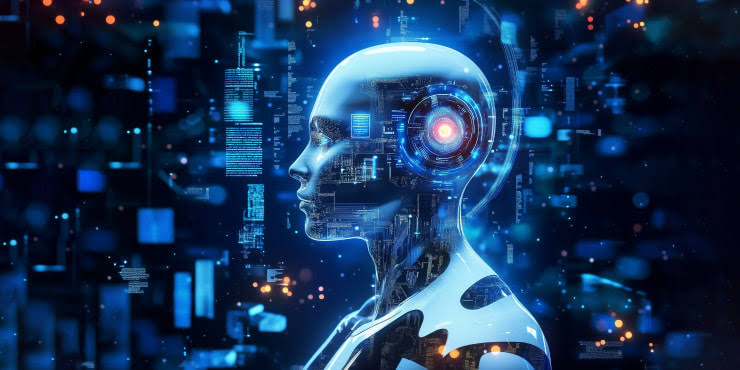Latest trends in artificial intelligence for 2025: 2025 marks a pivotal year for AI. It’s no longer confined to labs or gimmicks—AI is now reshaping entire industries, powering autonomous agents, boosting cybersecurity, and even influencing national policies. Governments, corporations, universities, and individuals all recognize AI as infrastructure, competitive advantage, and a societal force.

Whether deploying AI agents to automate workflows, integrating AI ethically, or embedding intelligence at the edge, the trends below capture AI’s broad reach and the caution it demands.
Latest trends in artificial intelligence for 2025
1. Agentic AI: Autonomous Task Execution
The rise of agentic AI—intelligent systems that autonomously plan, use tools, and perform complex, multistep tasks—is perhaps the most transformative trend of 2025.
- AI agents, such as those built on OpenAI, Anthropic, and Google tech, can juggle tasks like report generation, customer service resolution, software updates, and beyond with minimal human oversight
- Jensen Huang (Nvidia CEO) has heralded 2025 as the “Year of AI Agents,” citing enterprise benefits like autonomous code design and automated data tasks.
- Real-world impact includes Microsoft’s Copilot boosting sales rep productivity by up to 20%
Why it matters: Agentic AI elevates automation from scripted responses to self-directed problem-solving—a leap forward in efficiency and capability.
2. AI-Driven Cybersecurity & Ethical AI
As AI expands, so do its vulnerabilities—and its defensive power.
- AI-enhanced threat detection, behavioral biometrics, auto-response systems, and anomaly-based network monitoring are becoming critical defense tools
- A study warns that AI is poised to cut global cybercrime by automating patching and anomaly detection
- At the same time, Explainable AI (XAI), bias detection, and ethical AI development are gaining traction—boosted by regulators and public demand
Why it matters: AI isn’t just a tool—it’s a trusted, accountable partner that must avoid discrimination and safeguard privacy.
3. Edge AI & On‑Device Intelligence
Processing power is moving closer to users.
- Edge AI, where inference happens on-device (smartphones, cameras, IoT sensors), is scaling fast—reducing latency, costs, and improving privacy
- Innovators like Nvidia’s NPUs, Qualcomm’s chipsets, and on-device deep learning models are mainstreaming local AI .
- Analysts predict ~30–60% of consumer PCs and mobile devices shipping with built-in AI by end of 2025.
Why it matters: From instant translations in glasses to real-time industrial monitoring, edge AI makes responsive, private, and efficient interactions possible.
4. AI for Sustainability & Green Innovation
AI is now driving eco-efficiency across industries.
- AI-powered systems optimize energy usage and waste reduction—from bakeries matching supply to demand, to pollution-free transit planning .
- The rise of sustainable AI tackles data center energy consumption and electronic waste, while prompting algorithmic eco‑design
- Data centers and AI providers are committing to decarbonization strategies
Why it matters: It shows AI isn’t just tech-forward—it’s planet-aware.
5. Multimodal AI & Next‑Gen NLP
AI’s senses are expanding.
- Multimodal AI, combining text, vision, and audio, is delivering deeper, more nuanced understanding—e.g., AI financial advisors parsing speech, documents, and data.
- Advances in NLP are enabling human-like conversation, real-time translation, and context-aware chatbots—ushering in smarter voice assistants .
- Generative video AI is emerging from labs to applications, creating dynamic video from text prompts.
Why it matters: These AI systems are becoming truly conversational and immersive, blurring lines between user and machine.
6. AI in Education, Health & Business Decision-making
AI’s influence is educational, clinical, and corporate.
- Universities now teach AI fundamentals, chain-of-thought prompting, reinforcement learning, and hands-on deployment in business and finance programs.
- In healthcare, AI-driven mental health trackers and diagnostics await regulatory approval—reflecting cautious but rapid innovation .
- In business, Fortune 1000 firms shift from AI experimentation to scaling—integrating generative tools to personalize offerings and shave costs.
Why it matters: AI is not an abstraction—it’s embedded in how we learn, heal, and work at scale.
7. Sovereign AI & Regulatory Crossroads
AI is becoming a matter of national importance.
- European governments invest billions (€200 B+ EU InvestAI, national chip plants) to build sovereign AI capabilities.
- Regulatory frameworks like the EU AI Act, U.S. bipartisan bills (deepfake laws), and India’s AI Safety Institute are shaping safe, transparent deployment.
- Jensen Huang warns that cautious regulation could undermine Europe’s competitiveness; advocates for layered oversight to balance innovation and safety.
Why it matters: Controlling AI’s power demands sovereign infrastructure and ethical guardrails—everyone’s interests are at stake.
FAQs
What is agentic AI and why does it matter?
Agentic AI refers to autonomous systems that plan, execute, and adapt with minimal human input—elevating AI to independent decision-making. It transforms workflows and boosts organizational productivity by handling entire tasks or processes without tight human control.
How is AI changing cybersecurity?
AI-powered defenses now detect threats in real time using anomaly detection, behavior-based biometrics, and automated mitigation. They’re becoming essential due to growing cyber threats and complexity .
What’s the significance of Edge AI?
Edge AI enables real-time, privacy-sensitive data processing directly on devices—without cloud reliance. Expect its use in wearables, vehicles, industrial sensors, and PCs, offering faster, safer, and localized intelligence .
Why does AI need sustainable approaches?
AI data centers and large models consume vast energy and resources, contributing to emissions and e‑waste. Sustainable AI focuses on energy-efficient hardware, green energy, and smarter model training to minimize environmental impact.
How are governments shaping AI?
Multiple countries are investing in infrastructure (e.g., EU’s InvestAI, India’s AISI), and passing regulation (EU AI Act, US deepfake laws) to oversee AI’s deployment. They balance innovation with sovereignty, safety, and ethics.
What’s multimodal AI?
Multimodal AI simultaneously processes text, image, audio, and sensor data. It’s used for richer context-aware systems, like virtual advisors that understand voice, documentation, behavior, and environment.
Is AI replacing jobs or helping workers?
While some roles—especially repetitive, entry-level tasks—may be fully automated (e.g., at BT and Klarna), AI is largely being used as a partner, boosting human capability in customer service, code editing, decision support, and more .